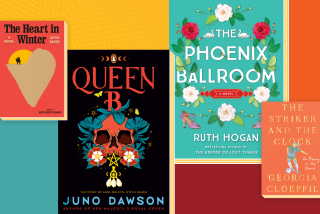DISCOVERIES
Drinking Coffee
Elsewhere
Stories
ZZ Packer
Riverhead Books: 256 pp.,
$24.95
“Drinking Coffee Elsewhere” is about survival: Imagining yourself elsewhere is one trick for living black in a white world.
Take the story, “Brownies,” in which an all-black Brownie troop from a southern suburb of Atlanta goes to sleep-away camp with an all-white Brownie troop. The story is shot through with meanness, conveyed in words like “cheap,” “small” and “Caucasian” and in the black girls’ mistaken identification of Troop 909 as “the enemy.” But Troop 909 is made up of girls with learning disabilities; they have pony tails and they are chirpy, qualities that were easily spotted from a distance, but in the end it is not so much fun to fight with them.
Because these stories by ZZ Packer are mostly about young people struggling to grow up, they make for raw reading. Sometimes you wish they’d go in a different direction. Decisions feel precarious, as if one bad move could ruin a life, as if every little thing were a neon sign blinking, “Go this way. Do this. No, no, not that!”
*
After
Francine Prose
Joanna Cotler Books/
HarperCollins: 336 pp., $15.99
Francine Prose did not earn her literary reputation by simplifying difficult issues, and she is not about to start now, even when her audience is at least 10 years younger than her usual readers. “After” is a novel for young adults that takes on not just the issue of violence in schools but also the tendency in America toward overbearing responses to crises and how disturbing and disorienting those responses can be for teenagers.
After five kids and three teachers are shot to death by some students at a high school 50 miles away, authorities at Tom Bishop’s school, Central High, react immediately. Tom and his friends are in 10th grade. The day after the murders they meet their new grief counselor, a scary, robotic, suspicious man who begins removing their privileges, one by one, against all logic. Their parents are brainwashed by terrifying e-mails. The children are introduced to metal detectors, guards, random searches, a dress code, urine tests and a TV that plays American propaganda. The result is paranoia. Children mysteriously disappear. Tom is given a warning when “Catcher in the Rye” and a rap CD are found in his locker.
Prose is clearly horrified by changes in American society, and writing to a younger audience allows her to express that horror. “After” describes a world in which the grown-ups clearly do not know what they are doing.
*
Stagolee Shot Billy
Cecil Brown
Harvard University Press:
285 pp., $29.95
You don’t have to know the ballad about Stagolee, the black anti-hero who shot and killed his old friend Billy over a hat in a bar one Christmas night in 1895 in Deep Morgan, the vice district of St. Louis, to enjoy Cecil Brown’s telling of the story behind the song.
“Stagolee,” writes Brown, “is a metaphor that structures the life of black males from childhood to maturity.” He compares the “ba-ad black hero” to Puff Daddy, O.J. Simpson, Malcolm X, Huey Newton (for all their differences). He traces the transformation of the song from ballad to blues, from pool hall to riverboat to work camp to Broadway. Brown, who grew up on the myth in the 1950s and ‘60s on a tobacco farm in North Carolina, reconstructs the very night when Lee Shelton dressed like a pimp in St. Louis flats and a “high-roller, milk-white Stetson” -- with an embroidered picture of his favorite girl on the headband -- wandered into the Bill Curtis Saloon in the Bloody Third District.
Brown’s reconstruction of the bordello culture in St. Louis is reminiscent of fin de siecle Vienna, portraying a kind of hysteria that played out on the stage and in the streets.
More to Read
Sign up for our Book Club newsletter
Get the latest news, events and more from the Los Angeles Times Book Club, and help us get L.A. reading and talking.
You may occasionally receive promotional content from the Los Angeles Times.







